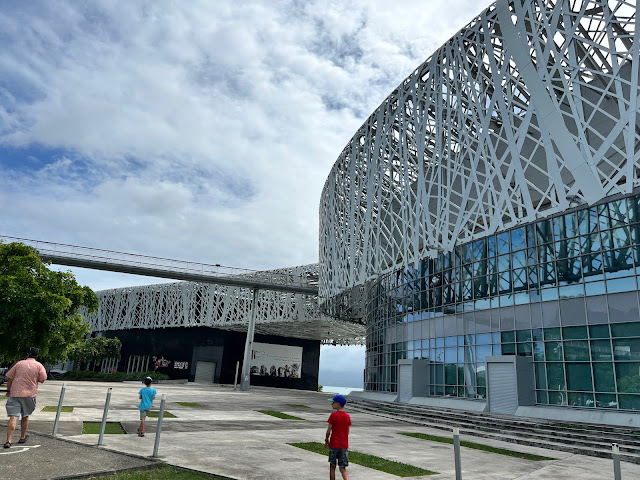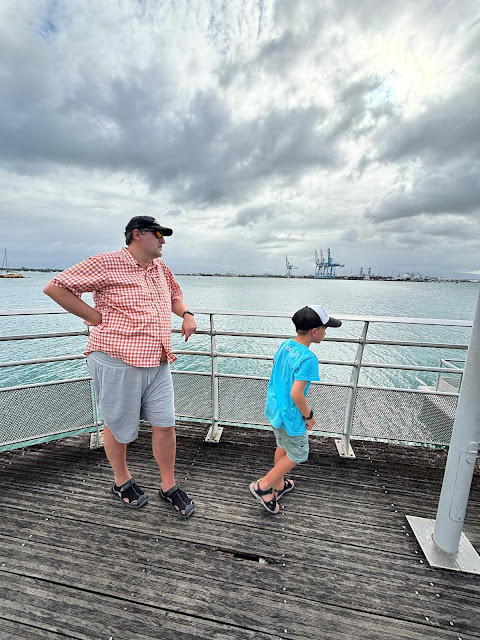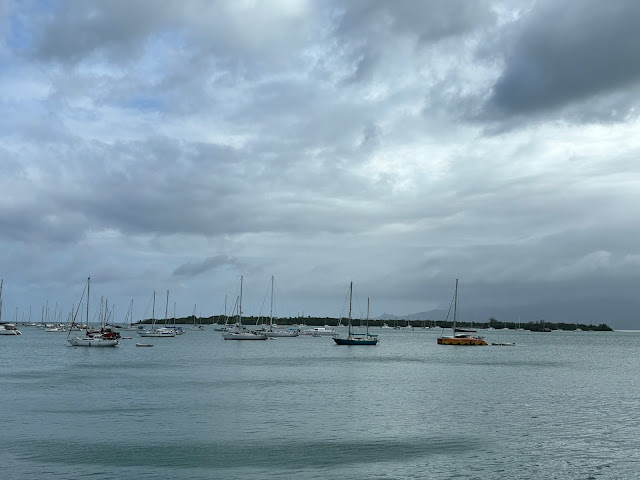Musée Mémorial ACTe de Guadeloupe
Our last hours in Guadeloupe, we spent in the Musée Mémorial ACTe in Point-à-Pitre. Quite a different activity from all the rest we had done on this Caribbean island, but we had read this as a must-visit activity and I agree it is.
The museum is a memorial ensuring the memory of the 13 centuries of trade in black people and slavery and is opened by President Hollande in 2015 on the site of a historic sugar factory.
After lining up for a strict security screening, which seemed very different from any experience on the chill Caribean island vibe, we had stored all our belongings in the designated lockers to go up to see the expositions. Pictures were strictly forbidden so what follows are some illegal pictures that I quickly tried to snap anyhow when nobody was near me, as I did want to capture a bit of what I found an impressive exposition with impact.
I expected, due to all good reviews, a good museum that would impact me. Spending time on this island, which is not always so well touristic developed, had made it very apparent to me how almost the entire populations has its roots in the historic imported slave population. Guadeloupe and many other carrebean islands has no longer any indigenous population. None. The entire population has been imported by Western colonists. I anticipated hard images and lessons on the hardships of the slaves and the injustice done to them.
But ACTe is much more factual, not playing too much on emotions, and takes the exposition much broader. It covers salve trade in history in all societies (Romans, Greeks, Chinese, Arabs, ...) which I didn't really consider much before entering. I learned about the flourishing African kingdoms which I also don't know much about it, the culture of intra-African slavery (14 million of slaves) next to Muslim slave trade etc before the transatlantic colonist slave trade started...the collaboration of some African kingdoms in this new transatlantic colonist slave trade and the economic global triangle that flourished. It showed me much more complexity and nuance than just a sad finger pointing "bad western colonists" story.
But it didn't taboo the hardships, the deaths, the toll, the doubtful position of the Catholic Church,... Sometimes the message was given without much words eg by a simple hallway where you literally have to step over the bodies of the chained slaves on a transatlantic ship: no words but a much more powerful image. It covered the life of slaves on the islands, the escapists, political movements, ... up to the current societies in North-America, Caribbean and Latin-America all grown from these slave populations, race tensions, movements and experiments to relocated back to Western Africa with mixed success up to the raise of Rastafarian movement and the Ethiopian emperor Haile Selassie and the success of Bob Marley. Ha, I did not anticipate learning about Bob Marley this afternoon.
It was a very educational couple of hours that I recommend.
But ACTe is much more factual, not playing too much on emotions, and takes the exposition much broader. It covers salve trade in history in all societies (Romans, Greeks, Chinese, Arabs, ...) which I didn't really consider much before entering. I learned about the flourishing African kingdoms which I also don't know much about it, the culture of intra-African slavery (14 million of slaves) next to Muslim slave trade etc before the transatlantic colonist slave trade started...the collaboration of some African kingdoms in this new transatlantic colonist slave trade and the economic global triangle that flourished. It showed me much more complexity and nuance than just a sad finger pointing "bad western colonists" story.
But it didn't taboo the hardships, the deaths, the toll, the doubtful position of the Catholic Church,... Sometimes the message was given without much words eg by a simple hallway where you literally have to step over the bodies of the chained slaves on a transatlantic ship: no words but a much more powerful image. It covered the life of slaves on the islands, the escapists, political movements, ... up to the current societies in North-America, Caribbean and Latin-America all grown from these slave populations, race tensions, movements and experiments to relocated back to Western Africa with mixed success up to the raise of Rastafarian movement and the Ethiopian emperor Haile Selassie and the success of Bob Marley. Ha, I did not anticipate learning about Bob Marley this afternoon.
It was a very educational couple of hours that I recommend.
Back outside we caught some fresh air at the port of Pointe à Pitre, with view across the bay at Basse-Terre where we had spend the last 2 weeks and then it was time to drive to the airport to return back to Europe.

















Comments